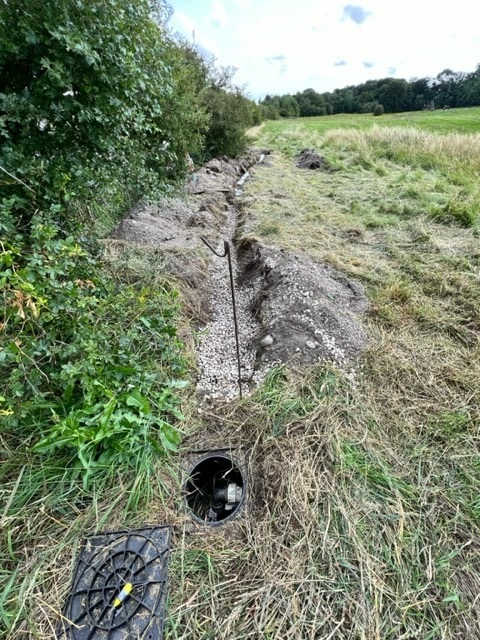What is a seasonal soakaway?

What is a seasonal soakaway?
The world of septic tanks, sewage treatment plants and soakaway systems can be complex and confusing - after all, there is no `one size fits all' approach for drainage systems. There are a number of variables that can affect the type of drainage system needed at any property - for example, the amount of space available, the type of ground conditions, and the access to the area for the heavy machinery required to undertake a new drainage system installation. When it comes to soakaways, also known as drainage fields, this can become even more complex, because the size and structure of any soakaway needed can depend on yet more factors which need to be taken into consideration during the planning and installation. One particular type of soakaway is known as a seasonal soakaway. So, let's look at this in more detail - what is a seasonal soakaway? When is a seasonal soakaway needed? What factors need to be taken into consideration, including any compliance and legislation?

First things first, it's important to note that a seasonal soakaway can also be referred to as a `partial drainage field'. In fact, you're more likely to see it referred to as the latter in formal documents such as the General Binding Rules - if you'd like to know more about septic tank and other off mains regulations in general you can check out our guide here. So, what is a seasonal soakaway, or a partial drainage field? The Gov.uk website, in its General Binding Rules for Small Sewage Discharge to a Surface Water defines it this way:
A partial drainage field is a length of perforated pipe that is installed between the sewage treatment plant and the outfall. It is installed instead of a solid pipe. This allows some of the waste water to soak into the ground when the ground is dry and flows in the watercourse are likely to be lower.
There are three types of off mains drainage tanks:
- Cesspit - this is essentially a holding tank for wastewater, and there is no outlet. It needs emptying frequently as a result.
- Septic tank - a septic tank provides basic treatment of wastewater (through separation) and the separated wastewater leaves the tank through an outlet. This can no longer be directly to a watercourse, and can only be to a drainage field.
- Sewage treatment plant - provides a greater level of treatment of the wastewater, which leaves through an outlet. A sewage treatment plant can discharge straight to a watercourse, or to a drainage field.
A seasonal soakaway can ONLY be used in conjunction with a sewage treatment plant. It effectively acts as a hybrid drainage field and a discharge to a watercourse, and it is needed when a watercourse doesn't have consistent flow all year round. Effectively, it makes best use of discharging to a watercourse when it is flowing properly, but with the back up of a drainage field when the ground is dry and the watercourse flow is lower.
Why are seasonal soakaways needed?
As we've outlined above, a seasonal soakaway can only ever be used with a sewage treatment plant. If you have a sewage treatment plant, and you apply for a permit through the Environment Agency, you are usually allowed to discharge straight to a watercourse - for example a ditch or a stream. However, the General Binding Rules set down that you are only able to do so if there is continuous flow of water throughout the year. It states:
Make sure the surface water has flow (rule 19)
You cannot meet the general binding rules if you have a new discharge to:
- a ditch or a surface water that does not contain flowing water throughout the year, unless there is a drought or an unusually long period of dry weather
- watercourses that seasonally dry up
What's the problem if the watercourse that you're discharging to occasionally dries up? Well, hold on to your stomach because when a ditch dries up and there's not a seasonal soakaway in place, black sludge appears in the ditch. This is because septicity starts to take place, in which the waste is going back to a septic state. The technical definition of septicity is the condition in which organic matter decomposes to form foul-smelling products associated with the absence of free oxygen - as you can imagine, something that most property owners would be very keen to avoid!
So, a seasonal soakaway enables the system to discharge to a local watercourse but effectively with the `back up' of a partial drainage field, to step in when the ground is drier and the flow within the watercourse has reduced.
What other considerations are there for a seasonal soakaway?
The main consideration is an assessment of the ground conditions at the property (through a percolation test), to ensure that a seasonal soakaway is an appropriate solution.
Rule 20 of the General Binding Rules is also specific about the layout and structure of the seasonal soakaway and states:
If you’re using a partial drainage field for a new discharge, the perforated section of the pipe must not extend more than 10 metres from the edge of the watercourse. You must only use it with a small sewage treatment plant, not a septic tank.
How much does a seasonal soakaway cost?
There are lots of considerations in the cost of a seasonal soakaway, including access to the site and ground conditions. However, as a guide, the typical cost for a seasonal soakaway is £1,250 + VAT, which allows for a 10 metre length of 100mm perforated pipe with spurs. A spur is a pipe coming off the main run towards the seasonal ditch.
Call the UK Drainage Professionals for seasonal soakaway installations
The team at the UK Drainage Professionals have decades of combined experience of all different types of drainage systems and soakaways, and we have installed many seasonal soakaways. We're always focused on finding the best solution for each customer and each property, ensuring that we comply with all relevant legislation and guidance. Get in touch today with us here to find out more about how we can help, and our friendly team can advise you on any next steps.
Let's stay in touch! Sign up for our helpful newsletter today

Sam's career prior to UKDP was spent in the marketing and service industries, so she is focused on making sure we look after our customers – and getting the UKDP message out there! Sam has overall responsibility for business operations and for delivering the best customer service we can.